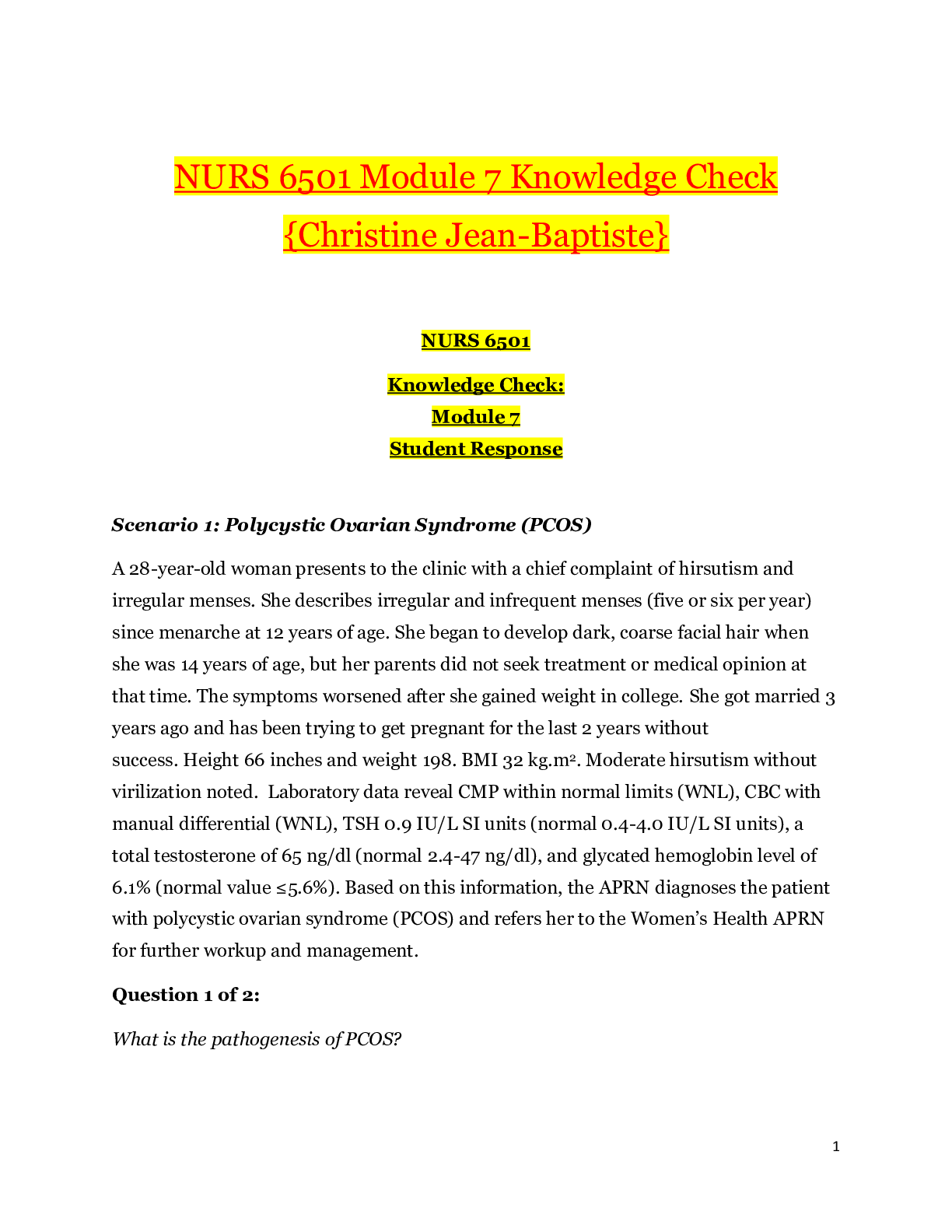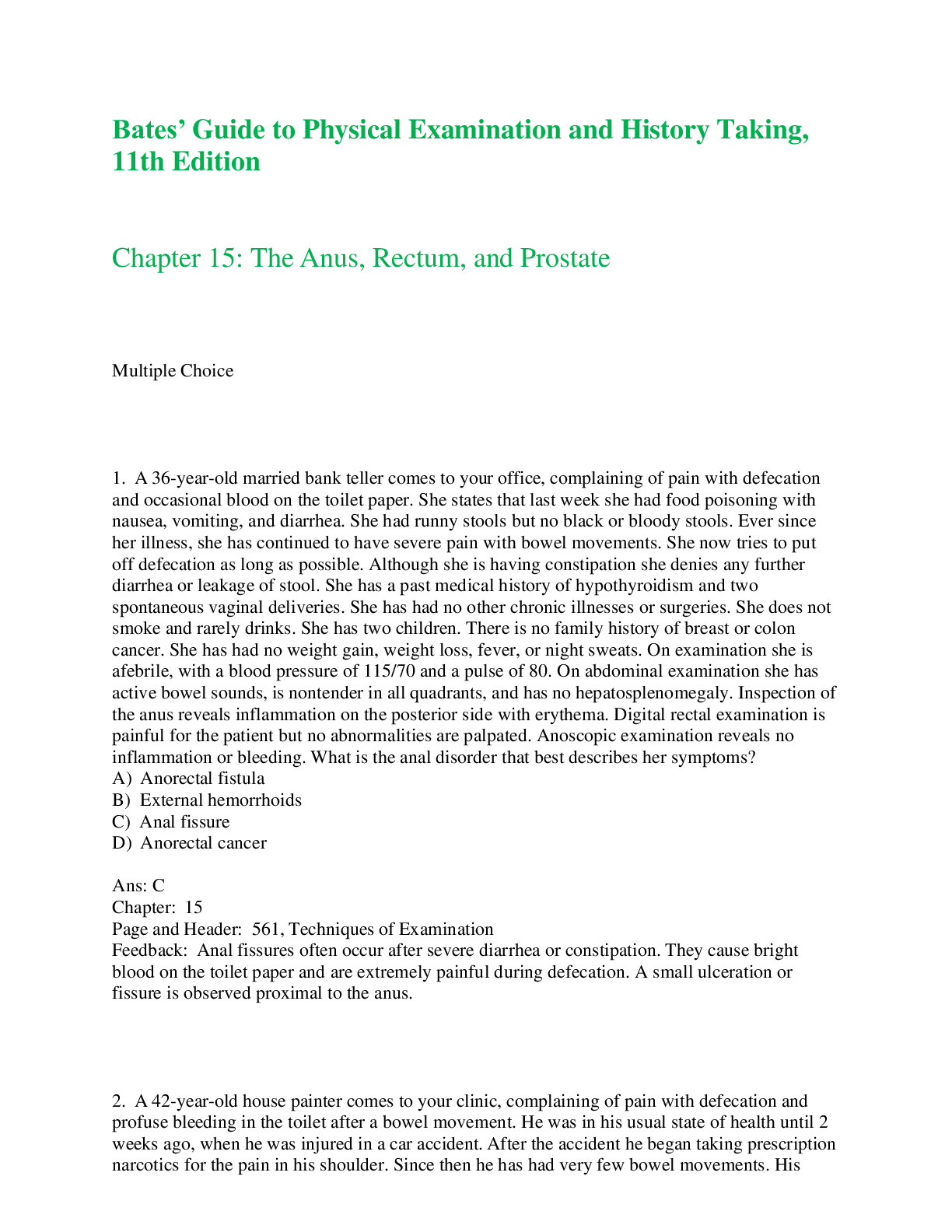HEALTH ASSESSMENT IN NURSING 6TH EDITION _ Chapter 5 _Graded A
Document Content and Description Below
HEALTH ASSESSMENT IN NURSING 6TH EDITION BY WEBER - Chapter 5 1. A nurse has completed a comprehensive assessment of a client and has begun the process of data analysis. Data analysis should allo... w the nurse to produce which of the following direct results? A) Outcomes evaluation B) Nursing diagnoses C) Holistic interventions D) An interdisciplinary plan of care 2. A new nursing graduate recently made an oversight during the analysis of a client's assessment data that resulted in a postoperative complication. What characteristic of data analysis makes it a challenging aspect of nursing practice? A) Abnormal data must be identified. B) It requires the prior identification of nursing diagnoses. C) It requires sophisticated diagnostic reasoning skills. D) Conclusions must be clearly and accurately documented. 3. A hospital nurse has identified a need to improve her critical thinking skills in an effort to improve client care. The nurse should identify which of the following characteristics of critical thinking? A) It is an innate skill that some individuals possess and which others do not. B) It does not include past experiences. C) It is based primarily on gNetting correct and timely information. D) It involves reflections on thoughts before reaching conclusions. 4. The emergency department has collected extensive data from a client who has presented with a new onset of severe abdominal pain. What nursing action should the nurse perform before proceeding with data analysis? A) Validate the collected data. B) Formulate a nursing diagnosis. C) Make inferences about the data. D) Identify the client's strengths. 5. A nurse has completed a client's initial assessment and is preparing to identify abnormal data and the client's strengths. Successful completion of this phase of the nursing process most requires which of the following? A) Knowledge of anatomy and physiology B) Awareness of the client's medical prognosis C) Inferences about the client D) Knowledge about the referral process 6. A nurse is planning a client's care following the completion of an initial assessment. When formulating a risk nursing diagnosis, which piece of data would be most useful? A) The client has an elevated white blood cell count. B) The client is 66 years of age. C) The client has pain in her joints, especially in the morning. D) The client is separated from her usual social supports. 7. During the assessment interview, the client made numerous statements that suggested his life generally exists in a state of harmony and balance. This fact would most likely prompt the nurse to identify which of the following? A) Actual nursing diagnosis B) Risk nursing diagnosis C) Collaborative problem D) Health promotion diagnosis 8. A nurse is caring for a client who has been admitted with an infected venous ulcer. The nurse determines that the client will need medical interventions as well as nursing interventions. The nurse would identify which of the following? A) Actual nursing diagnosis B) Referral C) Risk nursing diagnosis D) Collaborative problem N 9. A nurse has assessed a client and identified data that are associated with the diagnoses of Impaired Physical Mobility and Activity Intolerance. How can the nurse best determine which nursing diagnosis is most applicable to the client? A) Document preliminary conclusions. B) Identify abnormal data. C) Check the defining characteristics of the diagnoses. D) Test the nursing diagnoses clinically. 10. A nurse is analyzing the assessment data of a client who has been admitted with exacerbation of heart failure. The nurse has determined that the cue clusters meet the defining characteristics of specific nursing diagnoses. Which of the following would the nurse do next? A) Explain the client's problems to the client and his or her family. B) Verify it with the client and with other health care professionals. C) Validate the diagnosis with the physician. D) Work with the client to begin planning interventions. 11. A nurse's data analysis has led to the formulation of a risk nursing diagnosis. Which of the following best demonstrates accurate documentation of a risk nursing diagnosis? A) Risk for fatigue related to increased job demands, as manifested by feelings of exhaustion and frequent naps B) Risk for infection, as manifested by lack of client knowledge of wound care C) Risk for violence related to history of overt, aggressive acts D) Risk for altered respiratory function related to environmental allergens, as manifested by asthma 12. A nurse is preparing to document conclusions after analyzing data, and he or she includes information about related factors and manifestations. The nurse is formulating which of the following? A) Risk nursing diagnosis B) Actual nursing diagnosis C) Collaborative problem D) Problem for referral 13. A nurse is applying the diagnostic reasoning process in the care of a client. What is the correct sequence of the steps that the nurse should perform? A) Check for defining characteristics. B) Draw inferences. C) Propose possible nurNsing diagnoses. D) Identify abnormal data and strengths. E) Cluster data. D,E,B,C,A 14. The nurse has collected objective and subjective data during the assessment of a client who has been admitted for the treatment of an exacerbation of chronic obstructive pulmonary disease (COPD). During the current phase of the diagnostic reasoning process, the nurse is writing down thoughts about each cue cluster of data that was collected. The nurse is involved in which step of the diagnostic reasoning process? A) Step One: Identify Abnormal Data and Strengths B) Step Two: Cluster Data C) Step Three: Draw Inferences D) Step Four: Propose Possible Nursing Diagnoses Page 3 15. A nurse is determining whether the data for a client support a potential nursing diagnosis. The nurse is most likely engaged in which step in the diagnostic reasoning process? A) Step Three: Draw Inferences B) Step Four: Propose Possible Nursing Diagnoses C) Step Five: Check for Defining Characteristics D) Step Six: Confirm or Rule Out Diagnoses 16. A nurse is applying the diagnostic reasoning process in the care of a client with a number of comorbidities. Which of the following descriptions best characterizes Step Two, Clustering Data? A) Hypothesizing of any potentially applicable health promotion diagnoses, risk diagnoses, and actual diagnoses B) Documentation of all professional judgments along with any data that support those judgments C) Examining identified abnormal findings and strengths for cues that are related D) Evaluation of both subjective and objective data to identify strengths and abnormal findings 17. An experienced nurse is teaching a recently graduated colleague about common pitfalls encountered in the diagnostic reasoning process. The experienced nurse should identify a need for further teaching if Nthe new graduate identifies which of the following as a pitfall? A) View of things as either right or wrong B) Overemphasis on details C) Inclusion of valid data D) Clustering of unrelated cues [Show More]
Last updated: 2 years ago
Preview 1 out of 14 pages

Buy this document to get the full access instantly
Instant Download Access after purchase
Buy NowInstant download
We Accept:

Reviews( 0 )
$12.50
Can't find what you want? Try our AI powered Search
Document information
Connected school, study & course
About the document
Uploaded On
Mar 27, 2021
Number of pages
14
Written in
Additional information
This document has been written for:
Uploaded
Mar 27, 2021
Downloads
0
Views
102

.png)























